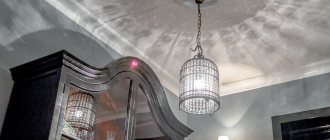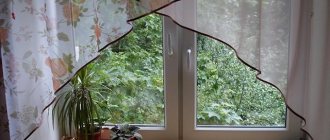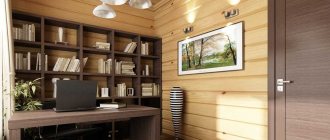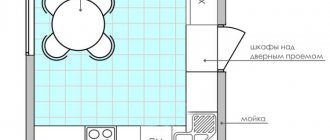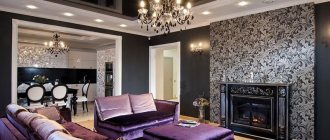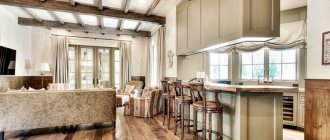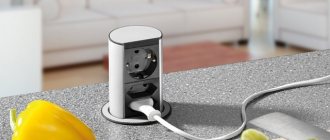The dining table should be well lit - who would like to look for food on the plate in the dark. Romantic dinners don't count!
Hang one or two lamps above the table, depending on the table configuration.
Distance to table
A pendant lamp in the kitchen above a table with a long cord should not hang too low - it will be easy to hit your head.
The lower edge of the lamp should be at least 100 cm above the table surface.
Place one lamp above the round table. The optimal diameter of the chandelier is about half the width of the table.
It is better to hang several pendant lamps over a long rectangular table - step back 30 cm from the edges of the table and place them at an equal distance from each other.
The best option for lighting the dining area are pendant lamps.
It is important that the lamp is beautiful, original, and unusual.
Switches
The switch plays an important role. They are determined with fittings depending on what design the model has. The following switch variations are available on the market:
- Most often used when pressing a keyboard. To turn on the light, simply press the key.
- By pulling the string, quickly turn on the corded one.
- Touch is easy to use. To turn it on, touch your finger to the special panel on which the sensor is located.
Each type has its pros and cons. When deciding on a choice, buy one that can highlight the style of the lighting fixture.
How to adjust the height?
If your chandelier is on a chain, adjusting the height is very simple by reducing the number of links. If the lamp hangs on a cord, this cord can also be easily shortened to the desired size.
But if the lamp has a rigid mount, the so-called rod, it is not always possible to change its height.
Therefore, carefully study the information in the manufacturer’s catalog, make calculations, taking into account the height of your kitchen, and only then buy the right model.
Basic safety requirements when installing sconces
Modern sconces are classified according to the method of connection to the electrical network into two main types:
- direct connection to electrical wiring;
- through the outlet and plug on the cord connected to the device.
In the first case, all the wires are “hidden” in the wall or body of the device, which makes operation safer. This option is ideal for a nursery or bathroom, when the presence of hanging wires and open sockets is not welcome. Also, such models have an aesthetic appearance and fit amazingly into the surrounding interior.
Products with a fork are more versatile. To install them, you do not need to leave wiring outlets or drill into the wall in advance; you can connect them anywhere near which there is an outlet. It is easy to move such sconces to another room or to another place when rearranging the furniture in the room. But there is a significant drawback - the stretching cord causes inconvenience and spoils the appearance of the wall. If there are small children or pets in the house, exposed live wires pose a source of danger.
The location and height of installation of electrical appliances are selected individually, based on the specific situation. A variety of factors are taken into account:
- the height of the ceilings and furniture next to which the lamps are installed. These could be dining tables, sofas or beds;
- interior style and wall decoration. So, quite often sconces are included in artistic compositions - drawings, paintings, hung next to mirrors and paintings;
- configuration and layout of the room, for example, the presence of arches, false columns, stairs;
- purpose of the room and arrangement of furniture.
But there are rules based on the sanitary requirements of SanPiN, SP, PUE, and safety precautions that should be followed in any case.
- Key switches for lamps in common rooms and bedrooms for adults are placed at a height of 80-170 cm. For children's rooms where small children live, this standard is 180 cm. This height allows you to protect the baby from contact with wires and electric current.
- It is recommended to install hidden wiring in bathrooms and toilets, which reduces the risk of short circuits due to increased air humidity and water droplets.
- In the kitchen, switches and the lamps themselves are located at a distance of more than 50 cm from the gas pipe, gas stove and flexible hose.
There are also illumination standards, expressed in Lux (1 lumen multiplied by 1 m2 of area) that you need to know about:
- places for work, reading, handicrafts – 300;
- children's – 200;
- bedrooms, living rooms, kitchens – 150;
- corridors, hallways, bathrooms – 50.
When making calculations, it is worth considering that the height of the sconce above the floor affects the area of the illuminated area and the scattering of light rays. The higher the device is mounted, the larger the illuminated area, and the dimmer the light itself.
Shape and size
Before choosing a lamp, decide on the size and shape. As a rule, the chandelier should not be larger than the width or diameter of the table. A single pendant lamp is usually used above a small round or square table. It can be small, or it can be impressive.
And just in this case, it is important to correctly calculate the diameter: subtract 30 cm from the diameter of the table, otherwise the lamp will “press with its volume” - those sitting at the table will feel discomfort.
Say, in a spacious room above a table with a diameter of 120 cm, a chandelier with a diameter of up to 90 cm will look beautiful and proportionate.
Choosing material
Usually, structures made of copper or brass are selected for arranging a bedroom to be attached to the wall. They look attractive and retain an attractive appearance for a long time.
Lampshades can be made from various materials:
- Products completely coated with chrome on top of the metal look attractive in modern rooms;
- Country style is emphasized by wooden lampshades;
- fabric lampshades will look good in a classic style;
- gypsum variations amaze with their attractive appearance;
- beautiful appearance of ceramic sconces;
- Glass sconces are popular; they are suitable for reading, providing directional light in the bedroom.
Various variations are used to decorate the lampshade. The surface is painted, rhinestones, mosaics or even precious stones are glued on.
How to move a lamp above a table?
Very often we see a situation where builders make an electrical connection for a lamp above the table approximately, give or take. And then it turns out that the chandelier hangs not where it is supposed to - ideally in the center of the table, but where it is necessary.
The case when the chandelier hangs in the center of the kitchen (unfortunate option)
This looks very sad, but there is a solution for this too! Choose a lamp with a long cord. Place the extra hook over the table and pull it through.
How to control the amount of light in the kitchen
Use a dimmer for the central chandelier or a 2.3-key switch, and all other lamps - general lighting, work area lighting, etc. - turn on using independent keys.
This is especially important with open floor plans, because in this way we not only create comfort for ourselves and our household members. But we also save energy.
A good solution is a height-adjustable lamp suspension: lower it lower when you want to create an intimate atmosphere at dinner or raise it to the ceiling if you need general, uniform lighting.
What methods of attaching chandeliers are there?
Hook mounting is the most popular method and one of the most reliable.
It is done quite simply: a hole of suitable width is made in the ceiling covering, then a metal hook is screwed into it, on which the lamp itself is suspended. This method is good because replacing the chandelier with another model is not difficult. The distance between the ceiling and the lamp is hidden in a special “glass”. Mounting strip - to hang a chandelier, a special thin strip is used, which is tightly screwed to the ceiling. The installation process of this mount is more complicated, but with its help you can hide the wiring well, since the lamp is attached very close to the ceiling itself. The cross strip is a very strong and reliable mount that can support the most massive and bulky chandeliers. Thanks to the width and thickness of the cross, the reliability of this design is significantly enhanced. Wall mounting using screws or nails - this method is used when installing wall lamps and sconces. For this purpose, special holes are provided in the product bodies, and the fastening materials themselves are often sold as a set.
How to hang a lamp above a table - design methods
Single lamp above the table
To create an atmosphere of intimacy and comfort, we use a pendant hanging low over the dining table.
Two identical lamps
If the light spot from a single lamp does not completely cover the surface of the dining table, find a companion for it.
If the table is large and elongated, make a line of single pendants, clearly defining the distance between the lamps.
Thin pendants are suitable for this, as in the photo above.
Two identical at different levels
If you have a large table, one light above it may not be enough. Instead of increasing the number of arms in your chandelier, break away from the patterns!
The height of the pendants does not have to be the same: asymmetry will add dynamics to an overly calm interior of the dining area.
Two identical pendants, different colors
Group of thin pendants
In interiors of a brutal nature, such as a style direction such as loft, thin pendants in the form of a set of lamps or a solid chandelier are often found.
Different pendants from the same series form a group
Light track
An elongated lamp over a long rectangular table
Chandelier over the dining table
Sconce lamp
Geometric lamp, pendulum
Group of identical lamps
Wiring connection
To connect electrical wiring, first turn off the voltage at the input panel.
Then follow these steps:
- determine the power supply system - three-wire or two-wire;
- then mark the separation of the wires at the place where the chandelier is connected to the wiring, the phase wires should have red, brown or black insulation, and the neutral wires should have blue or light blue;
- connect the phase and neutral conductors to the corresponding terminals of the chandelier; if the wiring also has a grounding conductor, connect it to the lamp body;
- if the chandelier has several lighting circuits or each LED lamp has a separate pair of terminals, then the sockets are connected to the wiring through special clamps.
After connecting to the wiring, the lamps are covered with a lamp cap, and decorative elements are installed. If the design of the chandelier includes a decorative cup near the ceiling, then it is also put in place.
